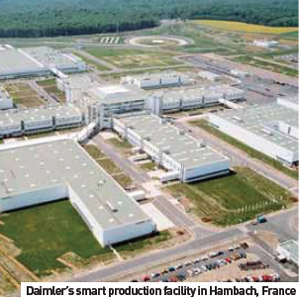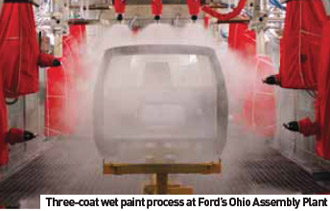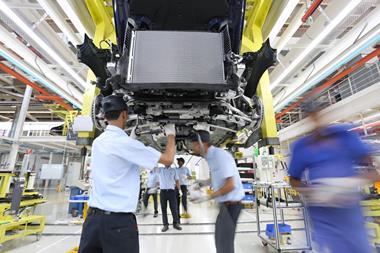
OEMs and Tier suppliers derive not only good public relations from minimising environmental damage in the vehicle manufacturing process, but may also realize significant cost savings.
One area that has seen a steady increase of environmental awareness and resultant action is the construction or updating of manufacturing facilities. Where firms would default to using virgin materials for every element of a new plant and its fittings, recycled metals, fluids and even gases are becoming more commonplace.
This is not being done just to save money. In some cases reputations are at stake, as various brands look for more ways to generate a substantial ‘green’ message in order to win over increasingly critical and eco-savvy consumers.
Clearly, it is no longer enough for manufacturers to pay lip service to environmental concerns. Consumers are increasingly aware of the rated CO2 emissions of their cars, while ‘well-to-wheel’ calculations are estimated as part of mainstream environmental impact criteria. It may only be a matter of time before individual production plants are targeted by consumer activists, in much the same fashion as recent campaigns against fuel-inefficient vehicles.
While any OEM failing to address the rising tide of eco awareness risks entering a minefield of negative publicity, most vehicle makers have now realised the importance of going beyond the minimum environmental guidelines when building or refurbishing plants. Beyond the questions about how green a given hybrid car might be, it is also important to reduce the impact its production has on the environment.
Long before General Motors evolved into today’s ‘new’ GM, the firm was far more environmentally proactive than its critics would care to admit. One of its most modern North American plants is Delta Township near Lansing, Michigan.
Intelligent touches abound, not only in the construction of the facility but also in the way the plant is operated. Factory floor lights turn themselves off when workers take their breaks, while roof cisterns collect rainwater for use in the toilets.
GM and the companies that have copied its Lansing initiatives are realising the same thing - sustainable manufacturing can help improve the bottom line. Eliminating waste is, after all, a founding principle of lean manufacturing.
 The 2006 construction of Delta Township saw General Motors questioning every part of the traditional fit-out process of a new facility. Instead of ordering costly, bespoke furniture, recycled or refurbished items such as cubicles and partitions were brought in from redundant facilities. Offering significant cost savings, such initiatives led to the facility being awarded Gold certification from the
The 2006 construction of Delta Township saw General Motors questioning every part of the traditional fit-out process of a new facility. Instead of ordering costly, bespoke furniture, recycled or refurbished items such as cubicles and partitions were brought in from redundant facilities. Offering significant cost savings, such initiatives led to the facility being awarded Gold certification from the
United States Green Building Council for Leadership in Energy and Environmental Design (LEED).
The LEED certification recognizes the materials and construction techniques employed, along with the adopted energy- and water-saving technologies.
GM believes it can further improve the paintshop at Delta Township, which uses approximately 80% of the water and 40% of total energy consumed. While the company admits that it has more work to do in this part of the overall site, Delta Township remains GM’s number one plant in North America for the recycling and reuse of primer.
Turning paint fumes into electricity
Plant designers know that environment-improving technologies are easier to incorporate into modern plants; an example is Delta Township. Yet a decades-old facility can still feature environmental innovations. The paintshop at Ford’s E-Series van plant in Avon Lake, Ohio illustrates this point. Ford calls the money-saving technology ‘Fumes-to- Fuel’. Essentially, it turns paint fumes into electricity that is returned to the power grid. The company claims enough electricity is generated from the process to illuminate a typical block of suburban homes.
Volatile Organic Compounds (VOCs) are removed from the paintshop air emissions using carbon beads, the clean air then released from the facility. The remaining scrubbed VOCs are then sent to a generator and turned into electricity.
Ford claims the paintshop at Ohio Assembly has reduced its VOC emissions by 10% and CO2 output by 20%. Cost savings are estimated at between $7 and $11 per vehicle.
According to Ford’s data, the global automotive industry produces 70 million pounds of paint fumes annually, collected and destroyed by pollution abatement systems. An estimated 24m pounds of paint overspray are captured in spray booths before being treated and consolidated into non hazardous sludge.
A further initiative sees the reclaimed paint sludge recycled into car parts. A bell-shaped spray applicator minimises overspray, with more paint adhering to the vehicle. But even with efficient applicators, there is always overspray. At Ford’s Michigan Truck in Wayne, Indiana, the sludge is dried and recycled into a liquid-applied material called LASD, helping to reduce noise levels in vehicle passenger compartments.
Waste gas used to power BMW paintshop
Another paintshop, this time at BMW’s Spartanburg complex in South Carolina, is recycling methane gas generated from nearby landfill. This, the OEM says, means an annual reduction of 17,000 tonnes in area emissions of CO2; a heat recovery equivalent of enough energy to heat 10,000 homes for a year. BMW, which installed a 9.5-mile pipeline running from the landfill to the facility, notes that almost 50% of the plant’s total energy is used in the paint shop, with annual savings on energy measured in the millions of dollars.
“The energy saved is significant - equivalent to the energy needed to drive a car around the globe 4,300 times or more than 100 million miles. This project allows us to take a previously wasted energy source and use it to generate electricity, which protects the environment and our community through lower emissions,” said Robert M. Hitt, Department Manager for Public Affairs at BMW Manufacturing at the facility’s launch. “Landfills are the largest human-made methane source in the United States.
Methane gas is a source of energy that is considered a greenhouse gas and otherwise contributes to air pollution.” Highly-efficient co-generation of electricity and hot water has been a part of BMW’s plan since construction of the Spartanburg plant began in 1993. The move to use recycled landfill gas to power the paintshop was first investigated in 2004. Durr Systems of Plymouth, Michigan, BMW’s partner in the landfill-to-paintshop gas initiative, also participates in the Environmental Protection Agency’s Landfill Methane Outreach Program. This initiative is designed to assist businesses seeking to lower operating costs and improve environmental performance.
BMW has recently updated its landfill gas reclamation system by replacing four turbines at the Spartanburg facility with two larger, more efficient examples. Officials say the move will save the manufacturer up to $2m annually, while reducing CO2 emissions by about 92,000 tons a year. The previous turbines had generated 14% of the electricity used by the plant, but BMW claims the new system will increase that to almost 30% of total needs.
 A Rolls-Royce might well be the very symbol of conspicuous consumption, but there is no doubting the green credentials of the company’s Goodwood assembly facility, located in the countryside of southern England. Not only was the factory partially built underground so as to blend into the surroundings, but the manufacturing process incorporates an extremely high percentage of recycled materials.
A Rolls-Royce might well be the very symbol of conspicuous consumption, but there is no doubting the green credentials of the company’s Goodwood assembly facility, located in the countryside of southern England. Not only was the factory partially built underground so as to blend into the surroundings, but the manufacturing process incorporates an extremely high percentage of recycled materials.
Rolls-Royce not only boasts a 75% on-site reclamation rate for a variety of waste items, including paper, cardboard, glass and metals, but parts are delivered to the Goodwood plant in reusable, recyclable containers.
A strategy that works well within Rolls-Royce’s small build volumes is the reclamation of woodshop remnants for sale to local manufacturers of wood products. Similarly, leather off-cuts are sold to buyers all over the world, including the fashion industry.
The Rolls-Royce manufacturing plant itself has a sedum ‘living roof ’, the largest in the UK. This, the company claims, makes it difficult to detect where building ends and surrounding country starts. Further, the effect is enhanced by the sustainably-sourced cedar wood cladding used on the buildings.
The planted roof of the factory attracts a variety of local wildlife, while a landscaped lake at the main entrance to the courtyard is in fact a key part of the water-management system. Over 400,000 trees and shrubs were planted to screen the buildings and further encourage flora and fauna into the area.
- Magna Steyr produces the tridion safety cell
- Continental is responsible for the cockpit module and installs it
- ThyssenKrupp assembles the rear axle drive module on site
- Plastal produces the body panels and other outer panelling on site
- Magna Uniport contributes doors and fl ap modules
Greening the distribution chain
Proudly calling itself ‘America’s First Green Dealership’, a Toyota retailer in Texas is in many ways showing where future vehicle plants should be heading, thanks to the high percentage of reclaimed materials used in its construction. Pat Lobb Toyota in McKinney, Texas, was built using as many energy-efficient and recycled materials as possible to help save money and reduce its environmental footprint. “I did this because it made business sense,” says dealership owner Pat Lobb.
Waste oil from vehicle servicing is used for heating, while vegetable oil replaces hydraulic fluid on the service department carlifts. The dealership also collects condensation from its 19 air conditioners, combining this with rainwater in an 8,660-gallon tank. The product is channelled into landscape irrigation. “In north Texas, we have a severe water shortage,” Lobb notes. “We received 525 gallons of water a day last August from the condensation collected from air conditioners.”
The exterior of the building was constructed from 95% recycled aluminium, while a security barrier is made from reclaimed elevator cables. Walls on the rear and sides of the building are covered in climbing trumpet vine to absorb the sun’s heat, while in the showroom itself, the ceiling tiles are formed from recycled newspaper, wool and starch. Even the positioning of the dealership was designed with environmental considerations in mind. Facing east, the afternoon sunlight falls on the back of the building, the green wall acting to absorb its rays.
While the building was approximately 7% more expensive over a conventional building, Loeb has realized significant savings in the three years the dealership has been open.
“Energy costs are going up,” explains Loeb. “We started with the premise that we could design a facility that would be as energy-efficient as any automobile dealership ever built, within financial reason. We determined what our potential energy savings would be and it appears that we’re approaching 20% a year in energy savings from this facility. If energy costs go up and you continue to save, then you’re the winner.”
Daimler continues to work with suppliers in order to cut down on waste resulting from delivered inventory. Many components now arrive in returnable containers, but where waste is inevitable, the OEM mandates that it is collected by the supplier and sent for recycling. Such processes are made easier by the fact that almost all the components are made on-site, meaning little effort is required to shift them from where they’re made to the assembly line. This alone, Daimler calculates, cuts emissions by up to 95%.
A smart car itself uses a high percentage of recycled materials in its manufacture, while the production process is entirely free of poisonous metals, such as lead and cadmium; two of the main reasons why Daimler is able to claim that up to 95% of every smart fortwo model is suitable for recycling.
A decade ago, the recycling and reuse of materials in vehicle plants was done mostly to save money. In the future, saving money will only be part of the benefi t. As consumers actively look for more environmentally oriented products, automotive brands that can show genuine, low-impact manufacturing will be the ones to prosper. For OEMs and Tier suppliers alike, this will require an ongoing track record of innovation.
Continuing efforts at the now 12-year old Hambach plant show that maintaining environmentally- aware manufacturing is an ongoing process. Daimler will be applying many of the lessons learned at Mercedes-Benz’s Kecskemét in Hungary, together with its own partner suppliers.
Environmentally-friendly dealerships may be novel in the US, but one European OEM had managed to do something similar over a decade ago. This, though, wasn’t just a single dealership - or even a group of outlets; it was the wholly-new plant built to produce the smart citycar.
 Formerly part of Mercedes-Benz but now a direct subsidiary of Daimler AG, smart is based in Hambach, France. Located in the hills of the Lorraine region , the facility was completed in October 1997, the facility built on reclaimed industrial wasteland. Even the plant’s exterior facade is eco-friendly, constructed from a material named Trespa, 80% of which comes from fast-growing European timber. Daimler also ensured that the building’s interior was free of materials such as formaldehyde, asbestos and CFCs. There are other initiatives. Rainwater from roofs is stored in tanks and used to temper steel, while other water draining off roads and employee car parks is funnelled into the oil separation plants. Once treated, it is held in special storage basins before being utilised for other functions. Meanwhile, wastewater from the plant’s sanitary installations and industrial processes is purified, after which the water is used as a coolant during the production process or for irrigating the plant’s landscaped surroundings.
Formerly part of Mercedes-Benz but now a direct subsidiary of Daimler AG, smart is based in Hambach, France. Located in the hills of the Lorraine region , the facility was completed in October 1997, the facility built on reclaimed industrial wasteland. Even the plant’s exterior facade is eco-friendly, constructed from a material named Trespa, 80% of which comes from fast-growing European timber. Daimler also ensured that the building’s interior was free of materials such as formaldehyde, asbestos and CFCs. There are other initiatives. Rainwater from roofs is stored in tanks and used to temper steel, while other water draining off roads and employee car parks is funnelled into the oil separation plants. Once treated, it is held in special storage basins before being utilised for other functions. Meanwhile, wastewater from the plant’s sanitary installations and industrial processes is purified, after which the water is used as a coolant during the production process or for irrigating the plant’s landscaped surroundings.
A central biological purification plant cleans all sanitary and industrial wastewater. Further, the plant uses biomembranes according to the BioSep process, a highly-flexible recycling method – the first time it was used in France.
As for the production line, it is housed in a building designed to save energy through reduced heat loss, while a gas-powered thermal energy station supplies hot water and some electricity. Daimler claims emissions have been greatly reduced compared to its older, less-efficient vehicle plants as the smart site burns natural gas rather than conventional fuels. Moreover, the efficiency of the system is boosted by the reuse of waste heat, while the materials used in the plant’s construction were checked against a list of environmentally harmful matter.
The paintshop has no need for cooling towers, as surplus heat from injection moulding equipment is used to heat the paintbooths, while the water-soluble paint and powder-coating processes eliminate solvents and reduce contaminants.
The paint process for the smart sees the chassis completely coated with powder paint. This efficient and environment friendly technique was an industry-first when introduced at the Hambach facility. Over and beyond its environmental positives, the method allows for a thinner paint layer than that achieved with conventional technologies. No solvents are emitted and no waste such as paint sludge is produced.
The overall process also incorporates a zinc-phosphating step without passivation – it is a lead- and cadmium-free process. Daimler’s strict ecological goals for the plant are also reflected in the recovery and reuse of excess materials, such as overspray powder.
The conventional supplier-manufacturer model is also different at the Hambach facility, whereby the manufacturer becomes a module system integrator, a process manager and producer. On the other hand, the system partners assume full responsibility for their own production. According to Daimler, this creates partners motivated to maximise profit across common business objectives.



































